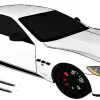DSG (Direct-Shift Gearbox) is a semi-manual, sequential or fully automatic gearbox, which is not equipped with a classic dry clutch system. It is responsible for controlling the speed and torque of a vehicle, depending on road conditions. Using an advanced electro-hydraulic control module to control gear changes, DSG offers the comfort of a fully automatic car while maintaining the increased efficiency of the manual gearbox.
Moreover, it is equipped with a double-clutch assembly, in which one clutch is responsible for even speeds, and the other for odd speeds, a categorization that increases efficiency and more. DSG is widely used by many car brands, such as Audi, Volkswagen, Skoda and others.
{{{ad-code}}}
However, DSG is a rather charismatic mechanism, so technical issues are no exception. Next, we will talk about the most common problems you may face if your car is equipped with this system.
Common 6-speed DSG problems
1. Vibration / tremor
Before discussing the possible problem of DSG, there is another cause of engine vibration that must be investigated first, because it is much more common: the transmission itself. If you notice vibrations especially when you start the engine and when the car is stationary with the engine running, accompanied by rattles and other similar noises, the problem is most likely the double-mass steering wheel, which is positioned between the transmission and the engine.
{{{ad-code}}}
The flywheel is composed of two plates that can move very little in relation to each other. This provides a buffer effect when torque is transferred from the engine to the transmission. When the flywheel wears out, the amount of movement becomes too large, and vibrations result.
If you have checked the flywheel and it is OK, and the vibrations are more obvious when changing gears (especially at lower speeds), the problem is most likely with the dual clutch device. Unfortunately, it is just a simple wear and tear, and the solution is one: replacement.

On the market, there are kits available to replace many components of the double clutch assembly, and in most situations, this will solve the problem. However, sometimes wear occurs on non-replaceable components, so you will need to replace the entire assembly. In our experience, this option is much more practical. Indeed, you can save money by using a repair kit, but if the damage occurs to the irreplaceable components, you will still have to buy a complete assembly, so you will end up losing money.
2. Mechatronic failure / mechatronic failure
{{{ad-code}}}
The box’s default or limp mode is a transmission failure state in which it detects a fault and is limited to a single speed (usually third or second) to limit transmission failures. Usually, this condition will be accompanied by the lighting of the “PRNDS” lights on board, the Check-Engine or Reverse Gear Not Available. If your car suffers from this defect, there are codes to explain why this happened. You will have to take your car to a service center with a diagnostic device to find out what those codes are.
If the codes say “clutch limit reached”, or something similar, chances are the clutch will be affected. Normally (but not always), this will only occur after the previous problem described (vibrations). When the code says “adaptations”, the problem may be resolved with an adaptation reset.
{{{ad-code}}}
If the codes mention sensors, transmission ratios or unexpected mechanical breaks, the problem is most likely related to mechatronics. Mechatronics is the name given to the electro-hydraulic control unit responsible for gearbox control, and is a very expensive component. Fortunately, it can be fixed.
Be careful, though! Car services are quite limited in what they can test and repair when it comes to mechatronic units. There have been many situations in which the test showed that mechatronics is OK, but in the end the only solution was total replacement.
3. Noisy bearings
The mechanical components of the DSG rarely fail. However, there are quite common situations in which the bearings wear out. This translates into a metallic noise you hear while driving.
{{{ad-code}}}
This problem is not the most urgent and can be postponed, but not for long. If the mechanical components fail, it can mean a catastrophe for the transmission. You need to replace the bearings, either by a service visit or at your garage, with a bearing kit.
4. Other issues
It is worth noting that, on certain occasions, a simple reset of the adaptation can solve a lot of minor problems, such as a faulty gear change. Resetting the adjustment involves small adjustments that the mechatronic system makes to things like the amount of pressure it applies to the clutch to compensate for wear or driving style.
{{{ad-code}}}
Another problem that occurs with vehicles with DSG is the loss of the ability to start the vehicle, accompanied by an error code about the parking / neutral switch. The problem in this case is that the mechatronic system receives wrong information about the position of the gearbox and does not let you start the car because it is not sure if it is in the park or neutral position. The component affected in this case is the derailleur itself, and not the transmission, although in some cases the cause may be from the cables.
Conclusion
No matter what the problem is with DSG, we advise you to treat it in advance. Any delay can cost you both money and more serious damage to the car.
{{{ad-code}}}
Photo source: autoportal.com, rdg.co.za, pinterest.com

